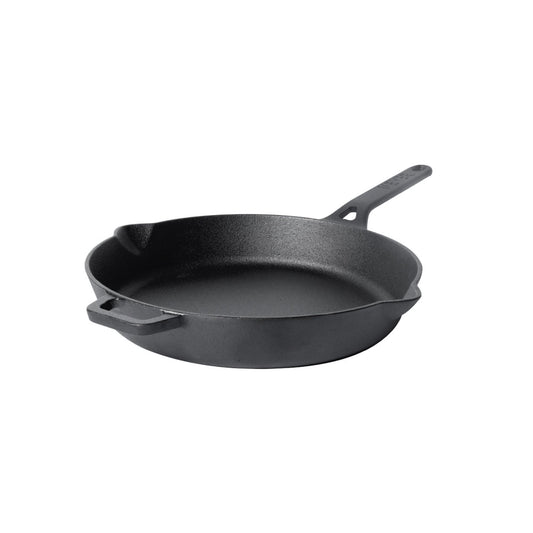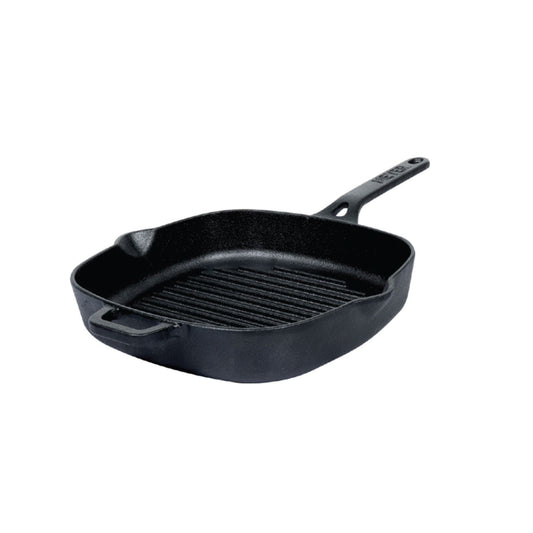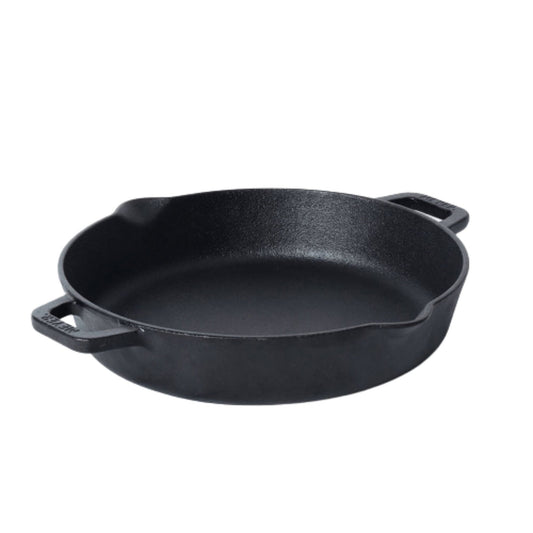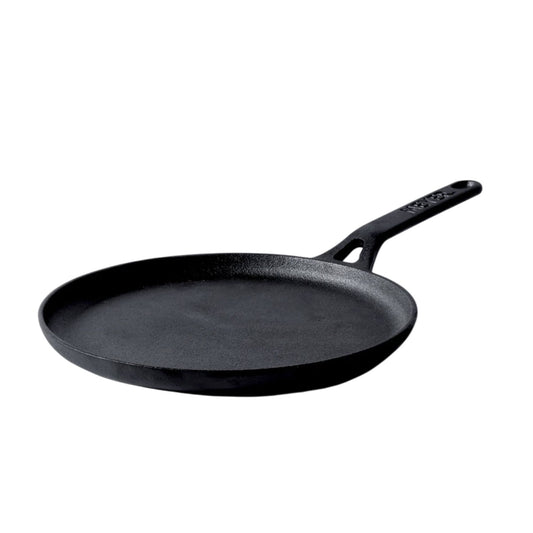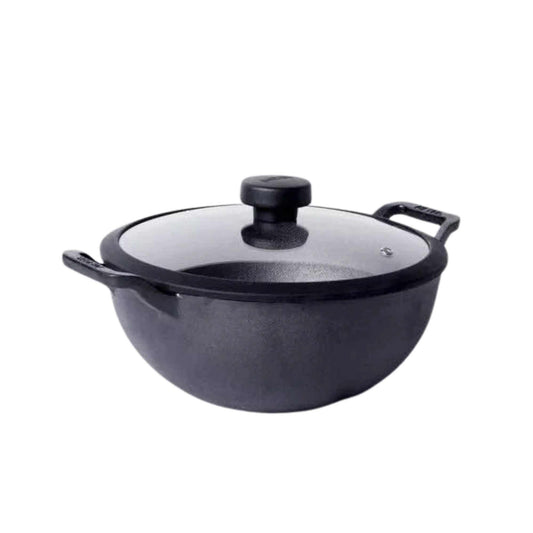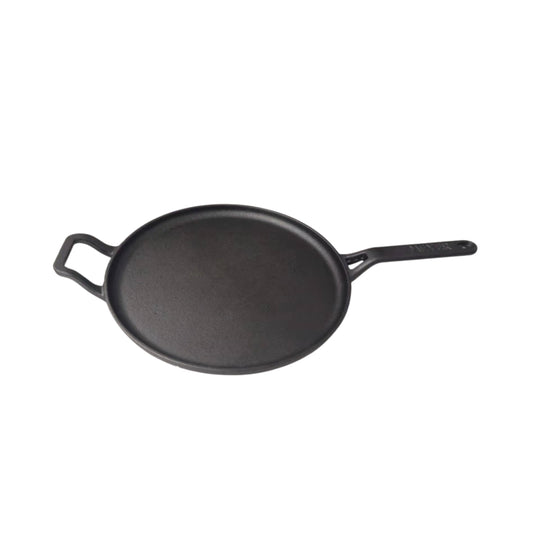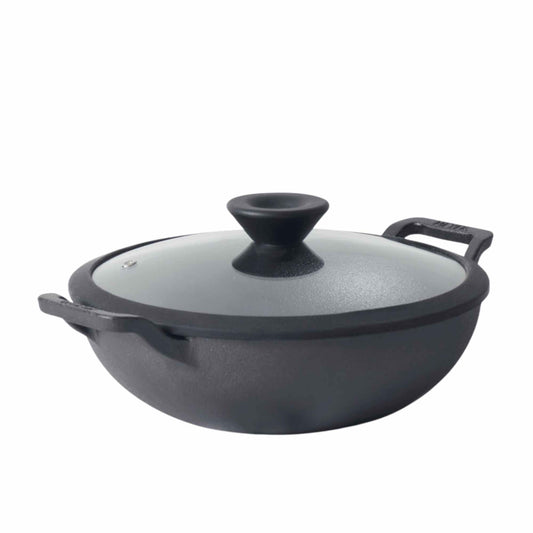Meyer Pre-Seasoned Cast Irons
Thank you for choosing Meyer pre-seasoned cast iron cookware. To ensure a long and pleasant experience with this product, please read this information carefully before using your cookware. These use and care instructions are for your general safety, and to avoid personal injury and damage to your cookware or property.
Re—seasoning your cast iron cookware
Cast iron cookware tends to rust if not seasoned properly. While your cookware has been pre-seasoned, you will periodically need to re-season it to maintain its stick-resistant and rust-proof finish. This process allows oil to be firmly re-absorbed into the iron. Well-seasoned cast iron cookware has a black colour which is normal and to be expected. If food starts to stick to the interior surface or if rust is present, you will need to re-season your pan as follows:
- Make sure you have the right kind of oil for seasoning your pan. Some examples of seasoning oil are flaxseed oil, sunflower oil, canola oil or soybean oil.
- Remove all food residue and rust by thoroughly cleaning your pan with hot, soapy water and a nylon brush. You may warm the pan up slightly on the stovetop to make this process easier.
- Dry the cookware thoroughly; you can do this by heating the pan until the moisture on its surface evaporates, and then allowing it to cool naturally.
- If using a gas stove:
- Apply a very thin, even layer of seasoning oil inside the pan.
- Thoroughly wipe off all excess oil with a kitchen towel — the pan should look matte and feel dry, not greasy to the touch.
- Place the cookware on the gas stove.
- Preheat the pan gradually starting on low heat, increasing the temperature slowly to medium high. Proceed with caution, as high flames may cause excess oil to ignite.
- Heat the pan until oil reaches its smoking point and no remaining oil residue is left. Repeat the process at least 2-3 times.
- If using the oven:
- Apply a very thin, even layer of seasoning oil inside and out.
- Thoroughly wipe off all excess oil with a kitchen towel — the pan should look matte and feel dry, not greasy to the touch.
- Place the cookware in the oven upside down and directly on the middle oven rack.
- Place a large baking sheet or large piece of foil on a rack below to capture drips.
- Targeting the smoke point of your seasoning oil, bake between 350°F/180°C to 450°F/230°C for one hour.
- Allow the cookware to cool down before removing the pan to avoid any injury to yourself/your property. Always use potholders or pinch-grips while gripping the handle.
- Store in a dry place, placing paper towels between the pan and lid (if applicable) and other items to absorb moisture and prevent rusting.
- Note: It is best to repeat this seasoning process several times to ensure your pan is well seasoned. We also recommend cooking high-fat foods in your pan for the first few uses for further seasoning of the pan. Avoid long simmering of liquid (e.g. soup) or acidic food (e.g. tomatoes, vinegar, citrus) to protect your seasoning.
Cooking

- General cooking: Before cooking, always preheat your cast iron pan gradually on low for a few minutes to ensure even heating. Add a generous amount of cooking oil after preheating to prevent sticking.
- Heat setting: Cast iron holds heat well. Once pre-heated, a low to medium heat seating is good enough for general cooking.
- Oven Use: This cast iron cookware is oven safe to 500°F/260°C (glass lid is oven safe to 356°F/180°C) and is safe to use under the broiler with the lid removed. Caution: Always use potholders or oven mitts when removing cookware from the oven.
- Utensils: This cast iron cookware is safe to use with all utensils, including metal. However, if you penetrate the seasoning while cutting in your pan, it may result in rusting, and you may need to re-season your cookware using the methods outlined above.
- Deep Frying: When deep frying, fill the pan to no more than one-third full of oil. Do not leave hot oil unattended and never use a lid. Use low heat when heating up oils, as oils can quickly overheat and cause a fire.
- Heavy Pot: When filled, cast iron cookware can be very heavy. Be extremely careful when moving cookware containing hot food, oils, and/or liquids.
- Unattended Cooking: Caution: Never leave an empty pan on a hot burner. An unattended, empty pan on a hot burner can get extremely hot, which can cause personal injury and/or property damage.
- Match Pan Size to Burner Size: Use burners that are the same size as the pan you are using. Adjust the gas flame so that it does not extend up the sides of your pan.
- BBQ Grill / Open Fire: When using cast iron cookware in an outdoor grill or over an open fire, the handles can get extremely hot. We recommend taking extra special care and using thick grilling gloves to handle your cookware if using them in this way.
- Microwaves: Never use cast iron cookware in the microwave.
- Thermal Shock: Cast Iron is constructed and tested to safely handle the normal and gradual temperature changes associated with cooking. However, thermal shock, sudden and extreme temperature changes to the object, its parts, its contents, or its immediate environment can damage the cookware. Situations conducive to thermal shock include but are not limited to actions such as pouring very cold food into a very hot pan, placing a heated pan directly into a freezer or vice versa, or drastically heating or cooling only part of the pan.
- Safety: Keep small children away from the stove while you are cooking. Never allow a child to sit near or under the stove while cooking. Be careful around the stove as heat, steam, and splatter can cause burns.
- Pet Warning: Smoke and smells from everyday cooking can be harmful to your bird and other small pets, particularly smoke from burning foods. Overheating cooking sprays, oils, fats, margarine, and butter will create dangerous smoke which a bird’s respiratory system cannot handle.
- Tabletop/countertop: When placing cast iron cookware on the table or countertop, place a trivet or hot pad under the hot cast iron cookware to prevent damage to your tabletop/countertop. Cast iron cookware that has come out of the oven or off the stovetop will be very hot so always use potholders when grabbing or moving hot cast iron cookware. We are not responsible for tabletop/countertop damage caused by hot cast iron cookware.
- This cast iron cookware is not intended for commercial use or restaurant use.
Cleaning & Storing
- Allow your cast iron cookware to cool before washing. Cast iron cookware can crack or break due to thermal shock; i.e. placing a very hot pan in cold water.
- Before first use and after each use, wash your cast iron cookware in warm water. We recommend cleaning your pan with a sponge or nylon brush. Never clean with scouring pads, steel wool, strip brush, or any abrasive tools.
- Use only a small amount of soap if needed, and never use harsh detergents (e.g. oven cleaner) on your cast iron cookware.
- If food remains on the surface, make a paste of coarse salt and water, apply to the pan and scrub with a nylon brush to dislodge the food particles.
- Dry well to prevent rust on exposed areas of cast iron.
- Apply a very thin coating of seasoning oil all over the pan. Wipe all excess oil to leave a dry, matte finish.
- Dishwasher: Never place your cast iron cookware in the dishwasher. Handwash only.
- Store your pans with the lids off to prevent rust build-up on exposed cast iron areas, and place paper towels between pans to absorb moisture.
- This cast iron cookware may crack or break if dropped onto hard surfaces or struck by another heavy object. Take care when handling and storing to avoid damage.
Handles

- Hot Handles and Knobs: Caution: Handles and knobs can get very hot under some conditions. Always use potholders when removing cookware from the stovetop or oven.
- Handle Position When Cooking: Position handles so that they are not over other hot burners. Do not allow handles to extend beyond the edge of the stove where pans can be knocked off the stovetop. When cooking on a gas stove, place the pan on the burner with the handle lined up with one of the burner grate arms to help prevent the pan from tipping.
- Never use a pan that has a broken handle.
Lids
- Steam: When removing lids, always position the lid so that the steam is directed away from you. Always use a potholder when removing or adjusting lids. Rising steam can cause burns.
- Do not place glass lids directly on a hot burner or place hot lids in cold water as this may cause breakage.
- Do not use steel wool while washing the lid as it may scratch the glass surface or damage the silicone rim of the lid.
- Do not use metal utensils, sharp instruments or harsh abrasives for glass lid cleaning as that may scratch and weaken the glass.
- A lid left on a pan after turning down/off the heat may result in the lid being vacuum sealed to the pan. If your lid is vacuum sealed to your pan, return it to the burner on low heat so the air inside the pan warms and expands to release the seal.
- Do not use glass lids that have cracks or scratches. If the lid is cracked or has deep scratches, please contact our Customer Service team for assistance.
Silicone Sleeves
If your cast iron product comes with silicone sleeves:
- Do not leave the silicone sleeves in a hot oven. Use the sleeves only for stovetop cooking.
- Keep the sleeves away from open flames and heating elements.
- Be careful moving full pans and pouring hot liquids with the sleeves on.
- It is advised not to leave sleeves on cookware for long periods while cooking as heat will eventually transfer to the sleeves.
Special Instructions for ceramic/glass stoves
Always follow your stovetop manufacturer’s instructions for correct stovetop use and for specific cookware restrictions. Cookware Brands will not be responsible for damage to stovetops.
- Never place a hot pan on a cool ceramic/glass stovetop burner. This can also cause fusion of the pan to the stovetop.
- Do not drag or scrape cookware across your stovetop, especially ceramic or glass ranges. This can cause scratches or marks on your stovetop.


